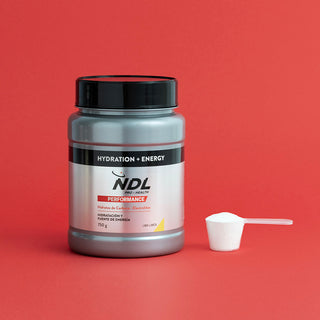

A brand of Rafa Nadal and Cantabria Labs.
Free shipping to mainland Spain from 24,95€.
Free shipping to mainland Spain for orders over €24.95
A brand of Rafa Nadal and Cantabria Labs.
Free shipping to mainland Spain from 24,95€.
Free shipping to mainland Spain for orders over €24.95
Your cart is empty
NDL Pro-Health Hydration + Energy is a dietary supplement with carbohydrates and electrolytes that helps you retain the proper level of salts and minerals in your body during physical activity and is a fast and stable source of energy for training.
Carbohydrate-based electrolyte solutions improve water absorption during physical exercise and help maintain the level of resistance for any exercise that requires prolonged resistance.
All NDL Pro-Health products meet the strictest quality criteria.
Consume one stick a day. Stir the content sufficiently to ensure it is properly mixed, tear off the top of the stick and consume.
|
INGREDIENTS |
G/DOSE |
ACTIVE/DOSE |
FUNCTIONALITY |
|
Maltodextrin |
25,103 |
Improved performance |
|
|
Fructose |
3,300 |
Excipient: Sweetener |
|
|
Sodium chloride |
0.300 |
117.78 mg Sodium 181.92 mg Chloride |
Isotonicity |
|
Sodium citrate |
0.300 |
70.2 mg Sodium |
Isotonicity |
|
Potassium chloride |
0.113 |
58.2 mg Potassium 52.8 mg Chloride |
Source of potassium/Control of pH |
|
Sucralose |
0.023 |
Excipient: Sweetener |
NDL PRO HEALTH Hydration + Energy does not contain any substances included in the WADA prohibited list either in its composition or in the manufacturing process.
Sports drinks containing electrolytes and carbohydrates are superior to water as a rehydration drink during moderate-intense exercise. These drinks contain sodium chloride and carbohydrates such as sucrose and glucose (maltodextrin). Gastric emptying improves whenever salts and carbohydrates are added to water, therefore improving its transport from the intestine to the blood compared to when drinking only water (1).
Carbohydrates obviously provide extra energy, especially when you are finishing your exercise. And certain athletes lose a large amount of salt through sweating and this salt has to be recovered if they are to remain hydrated. Apart from improving water absorption in the intestine, the salt in a sports drink stimulates thirst through the brain and minimises urine formation in the kidneys, thus improving the body's ability to retain body water (2).
Finally, whenever athletes warm up and start to sweat, they usually drink something more pleasant tasting than water (3). Glucose, sucrose, fructose, and maltodextrins (glucose polymer) are appropriate carbohydrates to make up a sports drink. Actually, as each carbohydrate enhances fluid absorption in the intestine through different pathways, having several types of carbohydrates in a rehydration drink may be beneficial (1).
MALTODEXTRIN: Several studies (4) recommend that maltodextrin can be used as an ergogenic aid to reduce fatigue and increase sports performance, since it promotes the recovery of muscle glycogen during and after exercise, increasing physical capacity, improving performance and preventing injuries in athletes, allowing a better recovery of energy reserves.
The administration of maltodextrin during high-load activity increases blood glucose concentrations, decreasing epinephrine concentrations, therefore reducing fatigue levels (5, 6).
SODIUM AND CHLORINE: (in the form of sodium chloride): A source of salt in sports drinks is critical, particularly during high sweating sports since water with sodium and chlorine (salt) is essentially lost through sweat (7). Furthermore, salt favours the isotonicity of the beverage and contributes significantly to preventing hyponatremia associated with exercise. Hyponatremia occurs whenever sodium levels in the blood plasma fall below certain limits (130 mM/L) and can lead to encephalopathy and pulmonary oedema depending on the degree.
POTASSIUM: While not to the same measures as sodium, plasma potassium levels tend to decrease during exercise (8). Potassium is essential for isotonicity, electrolyte balance, nerve transmission, and active transport mechanisms (7).
Do not exceed the expressly recommended daily dose. Dietary supplements should not be used as a substitute for a varied and balanced diet and a healthy lifestyle Keep out of the reach of young children. Contains caffeine (72 mg/stick): Not recommended for children or pregnant or breastfeeding women. Not recommended for people with diabetes. Store in a cool, dry place away from light, localised heat sources, sunlight and humidity. The indicated expiration date refers to the product stored correctly in the original packaging.
1. González J JA, Cobos H I, Molina S E. ESTRATEGIAS NUTRICIONALES PARA LA COMPETICIÓN EN EL FÚTBOL. Rev Chil Nutr [Internet]. marzo de 2010 [citado 21 de abril de 2023];37(1). Disponible en: http://www.scielo.cl/scielo.php?script=sci_arttext&pid=S0717-75182010000100012&lng=en&nrm=iso&tlng=en
2. Maughan RJ, Merson SJ, Broad NP, Shirreffs SM. Fluid and electrolyte intake and loss in elite soccer players during training. Int J Sport Nutr Exerc Metab. 2004;14(3):333-46.
3. Passe DH, Horn M, Stofan J, Murray R. Palatability and voluntary intake of sports beverages, diluted orange juice, and water during exercise. Int J Sport Nutr Exerc Metab. 2004;14(3):272-84.
4. Santesteban Moriones V, Ibáñez Santos J. Ayudas ergogénicas en el deporte. Nutr Hosp. 2017;34(1):204-15.
5. Wilburn DT, Machek SB, Cardaci TD, Hwang PS, Willoughby DS. Acute maltodextrin supplementation during resistance exercise. J Sports Sci Med. 2020;19(2):282.
6. Salazar Arteaga PA. Influencia de la ingesta de carbohidratos, en las etapas de sobrecompensación del microciclo, sobre los índices de fatiga de los futbolistas de la categoría juniors del Independiente del Valle. 2022;
7. Nutrition and Athletic Performance. Med Sci Sports Exerc. marzo de 2009;41(3):709-31.
8. Maughan RJ, Owen JH, Shirreffs SM, Leiper JB. Post-exercise rehydration in man: effects of electrolyte addition to ingested fluids. Eur J Appl Physiol. 1994;69(3):209-15.


Carbohydrate and electrolyte supplements
Do you want to stay hydrated and have a boost of energy while exercising?
NDL Pro-Health Hydration + Energy containing carbohydrates and electrolytes helps you maintain the proper level of salts and minerals in your body during physical activity and is a fast and stable source of energy for training.

Free shipping to mainland Spain for orders over €60
Secure Payments



Adding product to your cart
NDL Pro-Health Hydration + Energy is a dietary supplement with carbohydrates and electrolytes that helps you retain the proper level of salts and minerals in your body during physical activity and is a fast and stable source of energy for training.
Carbohydrate-based electrolyte solutions improve water absorption during physical exercise and help maintain the level of resistance for any exercise that requires prolonged resistance.
All NDL Pro-Health products meet the strictest quality criteria.
Consume one stick a day. Stir the content sufficiently to ensure it is properly mixed, tear off the top of the stick and consume.
|
INGREDIENTS |
G/DOSE |
ACTIVE/DOSE |
FUNCTIONALITY |
|
Maltodextrin |
25,103 |
Improved performance |
|
|
Fructose |
3,300 |
Excipient: Sweetener |
|
|
Sodium chloride |
0.300 |
117.78 mg Sodium 181.92 mg Chloride |
Isotonicity |
|
Sodium citrate |
0.300 |
70.2 mg Sodium |
Isotonicity |
|
Potassium chloride |
0.113 |
58.2 mg Potassium 52.8 mg Chloride |
Source of potassium/Control of pH |
|
Sucralose |
0.023 |
Excipient: Sweetener |
NDL PRO HEALTH Hydration + Energy does not contain any substances included in the WADA prohibited list either in its composition or in the manufacturing process.
Sports drinks containing electrolytes and carbohydrates are superior to water as a rehydration drink during moderate-intense exercise. These drinks contain sodium chloride and carbohydrates such as sucrose and glucose (maltodextrin). Gastric emptying improves whenever salts and carbohydrates are added to water, therefore improving its transport from the intestine to the blood compared to when drinking only water (1).
Carbohydrates obviously provide extra energy, especially when you are finishing your exercise. And certain athletes lose a large amount of salt through sweating and this salt has to be recovered if they are to remain hydrated. Apart from improving water absorption in the intestine, the salt in a sports drink stimulates thirst through the brain and minimises urine formation in the kidneys, thus improving the body's ability to retain body water (2).
Finally, whenever athletes warm up and start to sweat, they usually drink something more pleasant tasting than water (3). Glucose, sucrose, fructose, and maltodextrins (glucose polymer) are appropriate carbohydrates to make up a sports drink. Actually, as each carbohydrate enhances fluid absorption in the intestine through different pathways, having several types of carbohydrates in a rehydration drink may be beneficial (1).
MALTODEXTRIN: Several studies (4) recommend that maltodextrin can be used as an ergogenic aid to reduce fatigue and increase sports performance, since it promotes the recovery of muscle glycogen during and after exercise, increasing physical capacity, improving performance and preventing injuries in athletes, allowing a better recovery of energy reserves.
The administration of maltodextrin during high-load activity increases blood glucose concentrations, decreasing epinephrine concentrations, therefore reducing fatigue levels (5, 6).
SODIUM AND CHLORINE: (in the form of sodium chloride): A source of salt in sports drinks is critical, particularly during high sweating sports since water with sodium and chlorine (salt) is essentially lost through sweat (7). Furthermore, salt favours the isotonicity of the beverage and contributes significantly to preventing hyponatremia associated with exercise. Hyponatremia occurs whenever sodium levels in the blood plasma fall below certain limits (130 mM/L) and can lead to encephalopathy and pulmonary oedema depending on the degree.
POTASSIUM: While not to the same measures as sodium, plasma potassium levels tend to decrease during exercise (8). Potassium is essential for isotonicity, electrolyte balance, nerve transmission, and active transport mechanisms (7).
Do not exceed the expressly recommended daily dose. Dietary supplements should not be used as a substitute for a varied and balanced diet and a healthy lifestyle Keep out of the reach of young children. Contains caffeine (72 mg/stick): Not recommended for children or pregnant or breastfeeding women. Not recommended for people with diabetes. Store in a cool, dry place away from light, localised heat sources, sunlight and humidity. The indicated expiration date refers to the product stored correctly in the original packaging.
1. González J JA, Cobos H I, Molina S E. ESTRATEGIAS NUTRICIONALES PARA LA COMPETICIÓN EN EL FÚTBOL. Rev Chil Nutr [Internet]. marzo de 2010 [citado 21 de abril de 2023];37(1). Disponible en: http://www.scielo.cl/scielo.php?script=sci_arttext&pid=S0717-75182010000100012&lng=en&nrm=iso&tlng=en
2. Maughan RJ, Merson SJ, Broad NP, Shirreffs SM. Fluid and electrolyte intake and loss in elite soccer players during training. Int J Sport Nutr Exerc Metab. 2004;14(3):333-46.
3. Passe DH, Horn M, Stofan J, Murray R. Palatability and voluntary intake of sports beverages, diluted orange juice, and water during exercise. Int J Sport Nutr Exerc Metab. 2004;14(3):272-84.
4. Santesteban Moriones V, Ibáñez Santos J. Ayudas ergogénicas en el deporte. Nutr Hosp. 2017;34(1):204-15.
5. Wilburn DT, Machek SB, Cardaci TD, Hwang PS, Willoughby DS. Acute maltodextrin supplementation during resistance exercise. J Sports Sci Med. 2020;19(2):282.
6. Salazar Arteaga PA. Influencia de la ingesta de carbohidratos, en las etapas de sobrecompensación del microciclo, sobre los índices de fatiga de los futbolistas de la categoría juniors del Independiente del Valle. 2022;
7. Nutrition and Athletic Performance. Med Sci Sports Exerc. marzo de 2009;41(3):709-31.
8. Maughan RJ, Owen JH, Shirreffs SM, Leiper JB. Post-exercise rehydration in man: effects of electrolyte addition to ingested fluids. Eur J Appl Physiol. 1994;69(3):209-15.


Purchase options
Lo he probado como sustituto de las bebidas isotónicas preparadas y realmente funciona bien: sabor agradable (bastante neutro) y ayuda bien a la hidratación (durante y después del entreno), único punto negativo: cuesta que se disuelva bien
Complemento ideal para mis entrenos y partidos.
Cumple las expectativas, pero cuesta que se disuelva bien.
Para mis salidas largas en bicicleta va genial .top👍
Para mi es un imprescindible en mis salidas y si sobra algo hasta para la llegada me viene bien. Procuraré que no me falte.
Combine with


